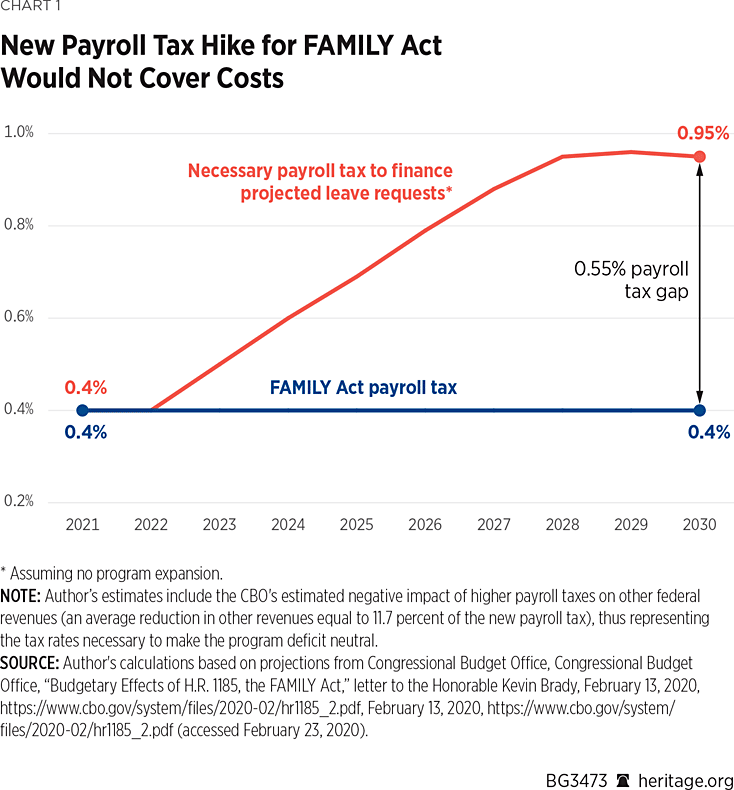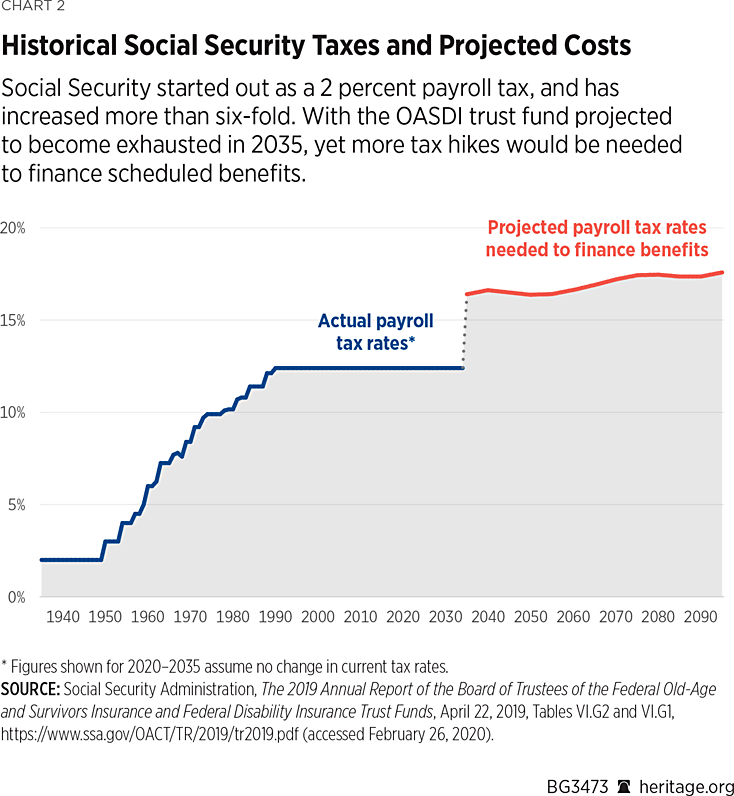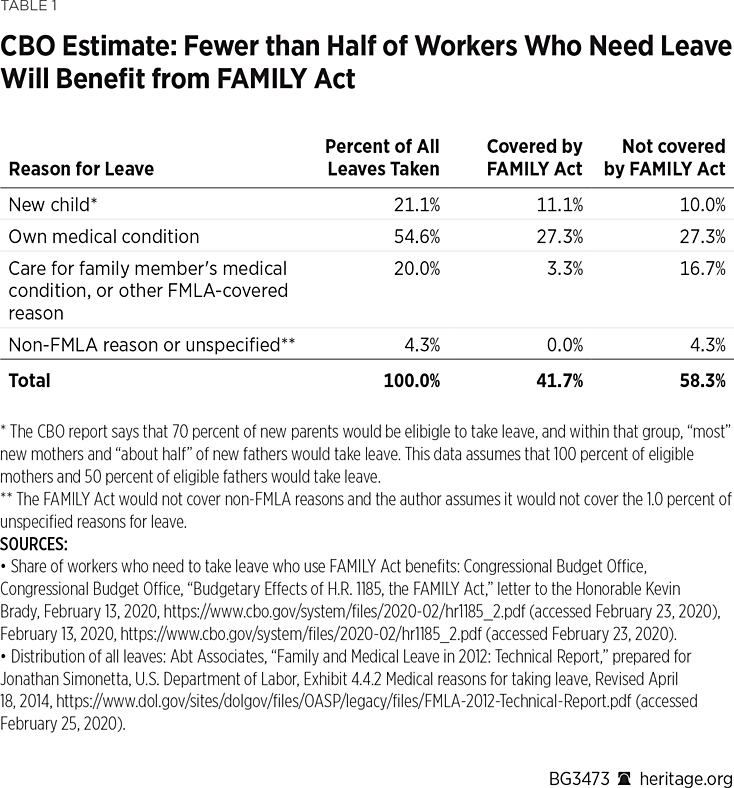Both conservative and liberal lawmakers are looking for ways to expand access to paid family and medical leave in the United States, primarily through proposals that would create new national entitlement programs. As history—both across the world as well as in some U.S. states—shows, such programs always expand in size, scope, and costs over time. Such programs have unintended consequences and often end up redistributing resources from lower-income workers and families to middle-income and upper-income workers and families.
As lawmakers consider the implications of a federal paid family and medical leave program, their decisions should be informed by the benefits and costs of such policies in the short-run as well as the long-run. A recent Congressional Budget Office (CBO) analysis of the Democrats’ proposed Family and Medical Insurance Leave (FAMILY) Act, as well as other analyses of proposals for, and evidence from, U.S. states and other countries, provide valuable information for lawmakers. There is no way to know for sure how a federal paid family and medical leave program would play out in the United States, but evidence and analysis suggest that such a program would cost far more than anticipated, expand in size and scope over time, fail to meet many workers’ needs, and have undesirable distributional effects.
The CBO’s Score for the FAMILY Act
The FAMILY Act would provide up to three months of partially paid family and medical leave for workers in order to address their own serious health condition, to care for an immediate family member with a serious medical condition, for the birth or adoption of a child, or for a “qualifying exigency” caused by the foreign deployment of a family member in the Armed Forces. Workers would have to meet certain work history requirements (such as having earnings over the previous 12 months) to qualify for benefits, and benefits would equal 66 percent of workers’ wages, with a maximum of $4,000 per month. A new payroll tax equal to 0.4 percentage points of wages up to Social Security’s taxable base ($137,700 in 2020) would finance the program, with workers and employers each paying 0.2 percentage points (and the self-employed paying 0.4 percentage points).REF
The CBO provided an analysis of the FAMILY Act in a February 13, 2020, letter to ranking Ways and Means Committee Member Kevin Brady (R–TX).REF That analysis concluded that the 0.4 percentage point payroll tax levied in the FAMILY Act would not cover the program’s costs. The CBO estimated that use of a federal paid family and medical leave program would rise over time as more and more people become aware of it as an entitlement. Although not specifically noted in the CBO analysis, there would likely be a shift, with workers who currently receive paid family and medical leave through their employers, receiving these benefits from the federal program instead—adding even more to the taxpayer burden.
The CBO stated that “the bill would establish an entitlement by creating a legal obligation for the federal government to provide benefits to applicants who apply and are deemed eligible.” Yet, the FAMILY Act “limits outlays to the amounts in the trust fund,” which is the accumulation of the FAMILY Act’s payroll taxes. As the CBO report shows, the FAMILY Act’s costs (including a decline in other federal tax revenues) would exceed its payroll taxes beginning in 2023, when the FAMILY Act program would have a roughly $7 billion deficit. Thus, in fewer than three years after the program was enacted and only one year after beginning to pay benefits, policymakers would have to decide whether to raise taxes or ration paid family and medical leave benefits.
Without rationing benefits, taxes would continue to rise. In 2023, the initial 0.4 percentage point payroll tax would have to rise by 25 percent to 0.5 percentage points. By 2026, the necessary payroll tax would need to double to 0.8 percentage points, and by 2028, it would need to rise to about 240 percent of its initial level, to 0.95 percentage points.REF

In dollar figures, the program would increase spending by $521 billion between 2020 and 2030, causing a $42 billion reduction in other federal revenues (as a result of employers reducing workers’ wages and benefits), for a net cost of $563 billion.REF Administrative costs, at 5 percent of benefits or $26 billion over the 2020–2030 period, would be substantial.
Explosive Growth in Entitlements and Paid Family and Medical Leave Programs
Most industrialized nations have generous government paid family and medical leave programs—which started off relatively modest, many of them similar to the provisions of the FAMILY Act. While taxes and benefits typically started out low for such government programs, virtually all programs have expanded significantly over time in an effort to accommodate more workers’ and families’ needs.
Between 1980 and 2011, the median amount of paid leave for mothers living in Organization for Economic Co-operation and Development (OECD) countries increased from 14 weeks to 42 weeks.REF In Canada, expansions—including increasing 17 weeks of paid maternity leave to 35 weeks of paid parental leave—caused the program’s costs to quadruple (from 0.07 percent of gross domestic product in 1980 to 0.28 percent in 2011).REF
Although the U.S. does not yet have a federal paid family leave entitlement, it has multiple other entitlement programs, all of which started out relatively small in size, scope, and costs, and mushroomed over time to create a huge fiscal threat to the U.S. economy. Social Security started out as a 2 percent payroll tax, but it now takes 12.4 percent of workers’ paychecks, costs 13.9 percent,REF and is projected to rise to 16.6 percent in 2040, according to Social Security Trustees.REF

Within the U.S., relatively new state-based paid family and medical leave programs have already expanded benefits and raised taxes in an attempt to increase awareness and utilization.REF In New Jersey, for example, only 40 percent of the population knows the program exists, and only 12 percent of eligible new parents and only 1 percent of eligible caregivers use the program.REF
New Jersey recently doubled the maximum length of leave to 12 weeks, increased the maximum payment level from 66 percent to 85 percent of earnings, broadened the group of employers to whom New Jersey’s state-based paid family and medical leave program applies to include those with 30 or more employees, and expanded eligibility criteria to include anyone with whom the employee has “the equivalent of a family relationship.” These changes are estimated to quadruple the maximum tax rate paid by workers.REF
First enacted in 2004, California has expanded its paid family and medical leave program at least three times to increase eligibility, raise benefit levels, eliminate a waiting period before qualifying for benefits, and increase the number of weeks available for leave.REF California’s governor and legislature are considering further expansions.
FAMILY Act Would Still Not Cover All Leaves
Despite a significant and growing cost, the CBO estimates assume that a significant number of workers who need and take leave will not use the federal program. This could be because the federal program would take time and effort to receive benefits (negating its use for shorter-term leaves), and a significant portion of workers who need leave would not meet the federal program’s eligibility requirements (about 30 percent of new parents would not be eligible). The CBO report does not note whether it incorporates lower usage rates among low-income workers who are less likely to be able to afford to take leave with the program’s partial 66 percent wage benefits. It does note, however, that some workers would not use the program because of non-financial reasons, such as fear of losing their jobs.
Overall, the CBO report estimated that about half of people who need leave for their own health conditions would claim federal benefits; about one in six needing leave to care for family members would use the federal program; and close to 70 percent of mothers and 35 percent of fathers would claim benefits for the birth or adoption of a child. Clearly, the cost of the program would be substantially higher if close to all workers who needed leave were to use the program.

How the FAMILY Act Would Hurt Low-Income Workers
Evidence from countries across the world as well as from U.S. states that have enacted government paid family and medical leave programs suggests that middle-income and upper-income earners would benefit most from a national paid family and medical leave program such as the FAMILY Act. Additionally, such a program would provide windfall benefits to companies—primarily larger companies—that already provide paid family and medical leave benefits to their workers.
According to a review of the economic literature on the distributional effects of government paid family leave programs by the Independent Women’s Forum, low-income workers tend to lose more than they gain from such programs, which, despite their intent, primarily benefit middle-income and upper-income earners.REF There are multiple reasons for these outcomes, including:
- Lower awareness. In California, only 35 percent of families with incomes below $35,000 were aware of California’s program, compared to 65 percent of families with incomes above 80 percent.REF In New Jersey, a poll found: “Lack of awareness is more prevalent among populations that could need paid leave the most, including people of color and young adults.”REF
- Inability to make ends meet with partial benefits. Low-income families face tighter budgets and are less likely to be able to pay their bills and meet basic needs with partial benefit replacements. The FAMILY Act would mean a worker who makes $15 per hour would have to get by on $396 per week instead of the usual $600.
- Lower eligibility. Low-income workers are more likely to work in part-time or temporary jobs where they do not qualify for benefits.REF
- Traditional gender roles. Low-income women are more likely to be stay-at-home parents, hence not qualify for benefits, while low-income men are less likely to take paid leave.REF
- Rigid rules and administrative barriers. Rules such as those prohibiting any work while on leave, as well as delays in processing applications, disproportionately deter low-income workers from using government programs.REF
- Job protection concerns. The FAMILY Act would not extend job protection to all workers, likely because doing so would create significant costs and administrative burdens for smaller employers. Low-income workers tend to be more concerned about losing their jobs if they take leave, and they are less likely to have job protection. According to an Urban Institute study, low-income workers are twice as likely to be employed by very small firms and one out of every three low-wage, low-income workers with children was employed by a firm with fewer than 10 employees.REF
Experience with Family Leave Programs in the U.S. and in Other Countries
As a result of these factors, many programs in the U.S. and in other countries have struggled to meet lower-income workers’ and families’ needs, even as they have grown in size and scope:
California. In California, 38 percent of the workforce has wages below $20,000, and yet only 1 percent of those low-wage workers use the state’s paid family leave program.REF Workers in the highest income bracket (above $84,000) were five times more likely to file paid family leave claims with the state as those in the lowest income bracket (below $12,000).REF Even in San Francisco, which has its own paid family leave law that provides 100 percent benefits to new mothers, low-income mothers (below $32,000) were only half as likely as higher-income mothers (above $97,000) to receive paid family leave benefits from the government.REF
New Jersey. New Jersey’s program was characterized as “simply unaffordable, even for middle-class families, many of whom still live paycheck to paycheck in high-cost New Jersey.” REF Moreover, “The state’s paid family leave policy puts many workers below the poverty level for the duration of their leaves, and pushes people who are already struggling deeper into poverty.”REF And, recent expansions of the program that are intended to increase awareness and use are estimated to quadruple workers’ maximum payroll tax.REF
Canada. Government paid family leave programs have exacerbated class inequality: “Despite proportionate and obligatory contributions of all employers and employees to these programs, the distribution of benefits is unbalanced and aids the social reproduction of higher-income families, especially outside of Québec.”REF While Quebec, which operates its own program, has taken action to increase government benefits, they “are still not equally used by mothers with lower socio-economic status.”REF
Norway. In Norway, which expanded paid leave to 100 percent replacement rates for nearly all mothers, researchers found that “paid maternity leave has negative redistribution properties,” and that “the extra leave benefits amounted to a pure leisure transfer, primarily to middle and upper income families.”REF The researchers concluded that “the generous extensions to paid leave were costly, had no measurable effect on outcomes and [also had] poor redistribution properties.”REF
In the U.S., where substantial employer-provided paid family leave exists, a government program could be even more regressive because it would provide windfall benefits to larger companies and higher-income employees who already have paid family leave policies.REF According to Deloitte representative Carolyn O’Boyle’s testimony before a Senate Finance Subcommittee on July 11, 2018, Deloitte instructs its workers who live in states with government paid family leave programs to use the state-provided paid leave benefits first, which Deloitte then tops off with its own benefits in order to meet the company’s maximum benefit. Similar transfers of private-sector costs to taxpayers would occur at the national level, and larger companies with large human resources departments would be the most capable of maximizing federal taxpayer-funded benefits.
Inevitable Expansions Would Cause Costs to Soar
The CBO report showed rising costs over time, even without an expansion in the program. As examined below, the FAMILY Act’s provisions would be insufficient to cover a large portion of workers’ leaves and would particularly fail to benefit low-income workers. Expanding the program to try to meet more workers’ needs would lead to even higher costs. Analysts at the American Action Forum found similar cost estimates for the FAMILY Act as the CBO, but when they applied higher utilization rates matching how much leave workers said (in a Cato Institute poll) that they wanted to take, the American Action Forum estimate showed costs soaring to a necessary 2.9 percent payroll tax—more than seven times the FAMILY Act’s proposed tax rate.REF
More Flexible, Efficient, and Accommodating Ways to Meet Workers Needs
It is important that family members be able to care for one another, and in a time when many households are headed by a single adult, or both spouses are working, providing necessary care can require taking time off work. Employers who fail to recognize and provide for this need risk losing good workers and incurring high turnover costs. Fortunately, a competitive global economy, recent pro-growth tax cuts and deregulatory actions, and the strong U.S. labor market are driving more and more employers to voluntarily provide paid family leave to their workers. This expansion in private provision is encouraging and most appropriate, as the overwhelming majority of Americans believe that employers—not the government, whether federal or state—should cover workers’ leave.REF
Yes, there are still workers who lack the ability to take paid family and medical leave, and there are businesses that cannot yet afford to provide it. And, policymakers can help generate paid family leave options that meet workers’ and employers’ unique needs, in flexible and accommodating ways, without enacting a new unfunded federal entitlement program.
- The Working Families Flexibility Act would benefit lower-income hourly workers by allowing them the choice to accumulate paid leave—so-called comp time—in exchange for overtime work.
- Universal savings accounts, or letting workers use other tax-preferred savings for paid family leave, would be particularly helpful for independent, part-time, and temporary workers.
- Expanding private disability insurance beyond the roughly 50 percent of full-time private-sector workers who currently have it would help workers to meet their own medical and maternity leave needs.REF
- Pro-growth tax and regulatory policies would help employers afford to provide paid family leave and help workers to afford taking leave.
Unlike a one-size-fits-all program, these policies would help to meet workers’ unique needs, at a cost they can afford.
Conclusion
Americans want paid family leave, and policymakers want to help them get it. But neither Americans nor politicians want another unfunded entitlement that expands over time and threatens the fiscal future of America. Americans want a program that meets their needs with as little cost, burden, and disruption as possible. A one-size-fits-all federal program simply cannot achieve this. Not only would it crowd out existing programs, shifting private costs to taxpayers, but, like other government entitlements and family leave programs, its costs would balloon over time and it would redistribute resources from low-income workers to middle- and higher-income workers.
Rachel Greszler is Research Fellow in Economics, the Budget, and Entitlements in the Grover M. Hermann Center for the Federal Budget, of the Institute for Economic Freedom, at The Heritage Foundation.



